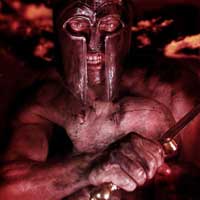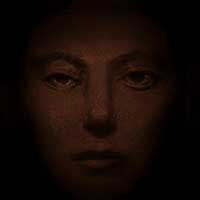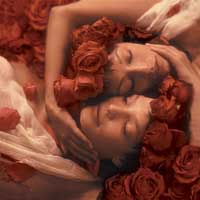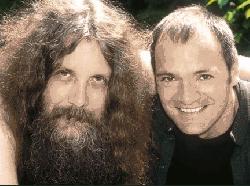- Comics
- Comics Reviews
- Manga
- Comics Reviews
- European Comics
- News
- Comics News
- Press Releases
- Columns
- Spotlight
- Digital Comics
- Webcomics
- Cult Favorite
- Back Issues
- Webcomics
- Movies
- Toys
- Store
- More
- About
By LJ Douresseau
April 20, 2004 - 10:44

 When Jae Lee debuted his own Image creator-owned comic, HELLSHOCK, round 1993, he had certainly dropped a hot book. Lee was a new fan favorite with a captivating style reminiscent of Bill Sienkiewicz. If there were a few things that separated the book from the rest of Image's line of mediocre titles, one of those things was Hellshock's stunning coloring. If you remember first seeing this book as I did, you may also remember asking yourself, as I did then, who is this colorist José Villarrubia?
When Jae Lee debuted his own Image creator-owned comic, HELLSHOCK, round 1993, he had certainly dropped a hot book. Lee was a new fan favorite with a captivating style reminiscent of Bill Sienkiewicz. If there were a few things that separated the book from the rest of Image's line of mediocre titles, one of those things was Hellshock's stunning coloring. If you remember first seeing this book as I did, you may also remember asking yourself, as I did then, who is this colorist José Villarrubia?
In the decade prior to Hellshock, numerous talented artists, illustrators, and craftsmen had come into comics with new skills, ideas, techniques, and equipment to change the way comic books were colored, the way the coloring looked, and what coloring contributed to art and story. Lynn Varley surprised us on her husband-to-be Frank Miller's RONIN and on the first arc of Chaykin's AMERICAN FLAGG! There was also Les Dorscheid on NEXUS, John Higgins on WATCHMEN, along with Richard Ory and Steve Oliff, among others.
But with Hellshock, Villarrubia was entirely different from other colorists. His work was "something else," a dissimilar way of approaching comics coloring. His method made him more than an assistant. He was the collaborator; his work established mood, atmosphere, context, character, setting, and story. The components, principles, and elements of the comic illustrations were as much his as they were "the creator's," in this case, Jae Lee. In mainstream American comics, Villarrubia has no peers and few contemporary colorists approach his level of work.
Since Hellshock, Jae Lee and Villarrubia have collaborated on SENTRY and FANTASTIC FOUR: 1234, and one can see the difference between Lee with Villarrubia and without; see the late 90's INHUMANS maxi-series from Marvel as an example of what it looks like when someone other than Villarrubia colors Lee's art.
Villarrubia has also collaborated with the much-loved comic book scribe Alan Moore on VOICE OF FIRE and has colored issues of PROMETHEA. Their new book is THE MIRROR OF LOVE. TMOL is Moore's epic poem about the history of same-sex love. The hardcover book of his poem will include over 40 full color photographs by Villarrubia. In recognition of this new book, I recently interview Prof. Villarrubia. Mr. Charlie #27 also includes images from TMOL and a photo of Moore and Villarrubia:
How did you become involved in The Mirror of Love project with Alan Moore?
JV: I first contacted Alan Moore to ask him for permission to turn the text version of TMOL into a one-act stage performance. He enthusiastically agreed. Years later, I was in the Angouleme International Comics Festival, when a French friend suggested that I illustrated a new version of TMOL. He asked Chris Staros if he would be interested in publishing it and Chris agreed on the spot. He asked Alan and Alan was, again very enthusiastic, given my previous involvement with the piece. Chris and his partner Brett gave me carte blanche regarding the format and size of the book. The result should be in stores in the beginning of May.
What artistic medium are you using to produce the illustrations for the book? If I understand it correctly, you're using photographs, but since I may not know what I'm talking about, it's best if the readers hear it from you.
JV: The book is illustrated with computer-manipulated photographs. First I sketch most of my ideas. Then I gather materials: locations, models and props. I then shoot the images and then, using Photoshop, work with them a little or a lot to turn them into what I have in mind.
What is The Mirror of Love about, and what are all the things that are going to be included in the book?
JV: It is an epic poem in prose recounting the history of homosexuality throughout the ages. The book contains a new preface by Robert Rodi, a new introduction by David Drake, an index of characters mentioned in the piece, a selection of poems and some other additional information. 136 pages in total.
I was surprised to learn that you'd adapted the book's story for the stage. Is something that you will perform again, and are you planning more such adaptations?
 JV: I'd love to do more adaptations, but they take a long time and effort. If the situation arises I will. I have done TMOL many times as a reading; without the staging, and I am sure once the book comes out I will do it again.
JV: I'd love to do more adaptations, but they take a long time and effort. If the situation arises I will. I have done TMOL many times as a reading; without the staging, and I am sure once the book comes out I will do it again.
What sort of impact do you hope it has on the comics industry? Do you look at The Mirror of Love as being more important that just another comics project and why?
JV: I am not sure if it will have any impact at all in the comics industry. First of all, it is not really a comic at all. Although it is sequential, it is more like a coffee table book. It is not more important that just another comics project. Some comics like MAUS, EPILEPTIC, STUCK RUBBER BABY and others are very, very important. It is just different.
You've mentioned before about reading comics as a child. Was there a point in your life when you started actively working towards being a cartoonist or comic book artist beyond any other artistic training you received. Or did you kind of fall into comics accidentally?
JV: Both. When I was fourteen or so I was drawing comics all the time: the characters I liked as well as my own. But I was rejected at seventeen by both Marvel and DC, and never applied again. Years later, as a college instructor, one of my students then, Greg Laroque, was a well established comics professional who asked me if I'd like to draw for DC. And I did. One pin-up. That was all since I did not want to do it any more. But then, a few years later, Jae Lee asked me to color HELLSHOCK. And a few years after that, my friend Stephen John Phillips asked me to work with him in the graphic novel VEILS. A few months later I started working for Marvel, and it has been pretty constant ever since.
If you don't mind, would you give us a little biographical information on yourself and why you moved from your birthplace Spain to Baltimore?
JV: Born in Madrid, Spain. Moved to Baltimore to attend the Maryland Institute College of Art where I am now a professor in the Illustration Department.
How did you become associated with Jae Lee and Hellshock? Why did you decide to color the book? Did Lee offer you the room to experiment without a lot of restrictions or demands about how to color the book?
JV: I curated an exhibition of local comics artist for an art center named Maryland Art Place and invited Jae to be a part of it. We became good friends and when he created Hellshock, he wanted a different look for it, more akin to the painted comics that [Bill] Sienkiewicz and others had done by then. He knew that I was a painter and could deliver a very different look from what was the Image standard at the time, so he asked me to color it with painted colors. He gave me complete freedom in how to color the book and I ran with it.
Why do you continue to collaborate with Lee? Is it that the two of you work so well together? I must say that the teaming has resulted in some exceptionally beautiful work.
JV: Well, first of all because we are very good friends and understand each other very well. After working together all these years we have developed a system of mutual trust, so he knows what to expect from me and vice versa. Jae is one of the top talents in the industry and always gives me room to do something interesting with my colors.
As a colorist, do you emphasize surface beauty or is there more to the process and the finished work?
 JV: I think that you know the answer to this one. The first thing that is important to me is the mood of each scene, which I try to accentuate by creating color harmonies for each page. The contrast between these moods, affects the storytelling, by empathizing the underlined psychological tone of each moment in the story. Of course, I want each page to be beautiful, but there are hundreds of ways to make each page beautiful. The color should always be more than, though. It should be appropriate to the content of the story.
JV: I think that you know the answer to this one. The first thing that is important to me is the mood of each scene, which I try to accentuate by creating color harmonies for each page. The contrast between these moods, affects the storytelling, by empathizing the underlined psychological tone of each moment in the story. Of course, I want each page to be beautiful, but there are hundreds of ways to make each page beautiful. The color should always be more than, though. It should be appropriate to the content of the story.
If it doesn't take to long for you to do so, could you describe the process you use to color? Do you color by hand or with a computer or is it a combination of both? And has the process changed a lot from Hellshock to now?
JV: It is a combination of both. I paint the pages by hand, in watercolor, gouache and acrylic, scan them in the computer and modify them in Photoshop. In the beginning most of the work was done by hand, and now most of the work is done digitally.
In another interview, you listed the comics that you liked to read (Optic Nerve, the late Penny Century, ACME Novelty Library), so I have a two-part question:
1. Do you plan on producing any sequential comics or do you consider your work painting and coloring comics as your contribution to sequential comics?
JV: You never know. I have nothing in the works right now in terms of my complete art in sequential for. But I have done more than just coloring in the past (Veils, PROMETHEA) and I may do some more again for the right project. I might be doing the complete art for a sequential story that Alan wrote.
2. Would it be correct to consider comics fine art? Or would someone have to take it out of sequence and examine an individual page or single, static image to consider if that is fine art?
JV: Comics are art. Not all art is great art. Look at Thomas Kinkade. Sequential images can be seen as art outside of their original context. Hence illustrations taken out of books or still images taken out of film. Both can be art. Fine art is generally not done for a client, unlike commercial art, but the definitions are flexible. Many comics are not done for an editor or publisher, but find one later. The distinction between fine and commercial art has become somewhat obsolete.
Another way to look at that might be to examine the entire presentation or package (as three-dimensional art), such as an issue of Dave Cooper's WEASEL or Chester Brown's LOUIS RIEL (or almost any Brown book for that matter), in which the artist designs and produces every facet of the book - from the interior graphic narrative to the design of the letters page, author's notes, indicia, etc.
JV: I get your point, but art does not have to necessarily be the product of a single individual, either. There is a long history of collaborations in both fine and commercial art.
Or am I just wacky? Comics are no more related to visual art than it is prose art. So comics are somewhere between fine art and literature?
JV: JV: No, you are not wacky. And no comics are more than the sum of their parts. Like film, video, dance, theater and other arts, comics are a time-based medium that is distinctly different as an experience from its components. You would not call film a medium between photography, theater and music, would you?
Now that I have that out of my system; what work by you should we be on the lookout for beyond The Mirror of Love?
JV: I have a few cookies in the oven. Right away you will see the closing issues of Promethea, in which I worked with the super-creative J. H. Williams in what I think is his best work to date. I will also be coloring the mega-talented Karee Andrews in a Doctor Octopus mini for Marvel, and the ultra-cool Paul Pope for his Solo one shot. My following projects have not been announced yet, but hopefully soon.
I usually close an interview by asking the subject if he has something he wants to say. You may plug some project, alert us to something, or even give a shout out. So have at it?
 JV: What is a shout out? I have never heard the expression. The only thing I can think of is to wholeheartedly recommend the short stories of Kelly Link. I have been reading all of them and I can't recommend them enough! She's genius; look her up!
JV: What is a shout out? I have never heard the expression. The only thing I can think of is to wholeheartedly recommend the short stories of Kelly Link. I have been reading all of them and I can't recommend them enough! She's genius; look her up!
THANK YOU, PROF. VILLARRUBIA! If you want more info on the artist, there is a huge interview of him at http://www.gayleague.com/forums/display.php?id=207 along with images of his work. You can go to www.topshelfcomix.com to order your copy of The Mirror of Love, regular edition or signed book. Amazon.com also has for sale a number of books to which Villarrubia has contributed, including VERTIGO VISIONS by Alisa Kwitney and VAMPS AND TRAMPS by Camille Paglia. Also look for his collaborations with Daniel Zezelj on SUPERMAN: METROPOLIS and with Stephen John Phillips on the graphic novel VEILS.
If you are interested in Kelly Link, the writer José recommended, you can find this rising star of fantasy fiction's work at Amazon.com. Her first short story collection is STRANGER THINGS HAPPEN from Small Beer Press (ISBN: 1931520046). Ms. Link also edited TRAMPOLINE: AN ANTHOLOGY, an anthology, of course, of mostly original fiction, also from Small Beer Press.
And if you are a comics creator or publisher and you want to send me material for review consideration or you just want to talk about your book in a Charlie column, punch the click-able name link to send me an email. Holla!